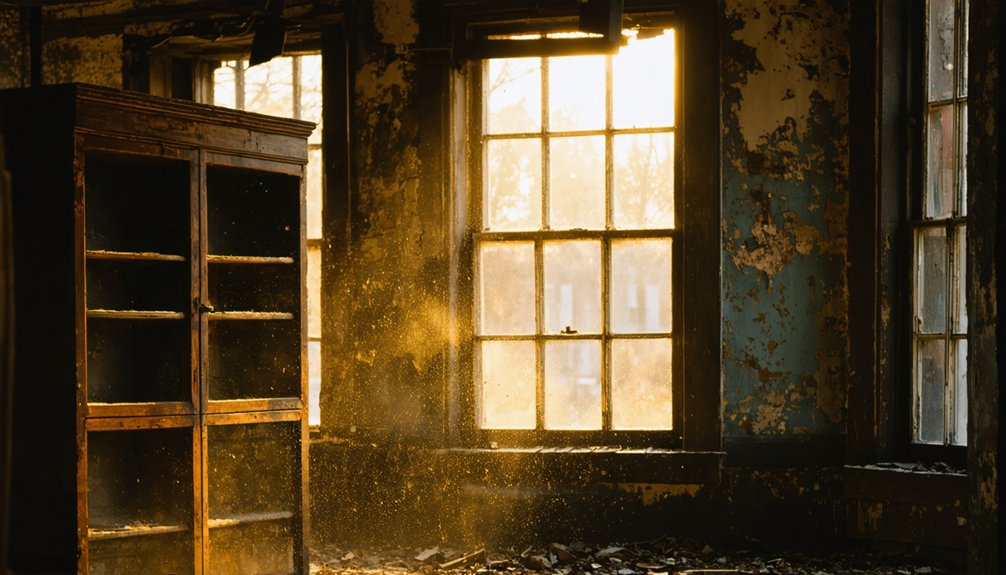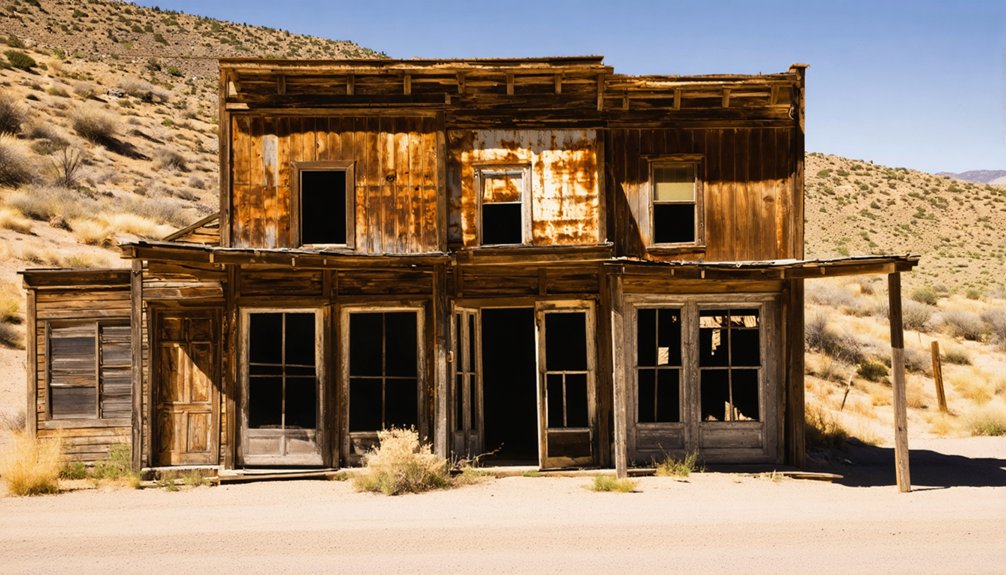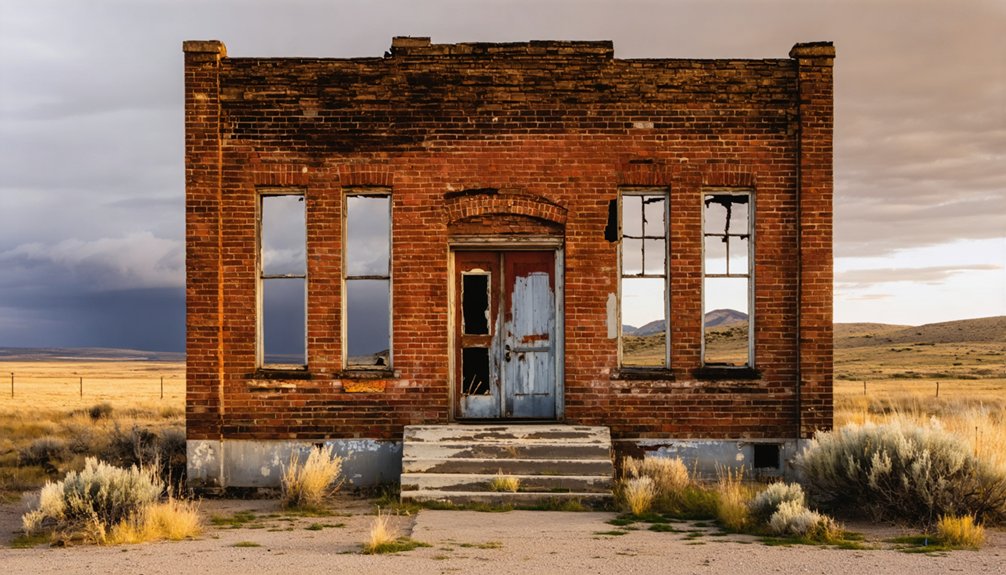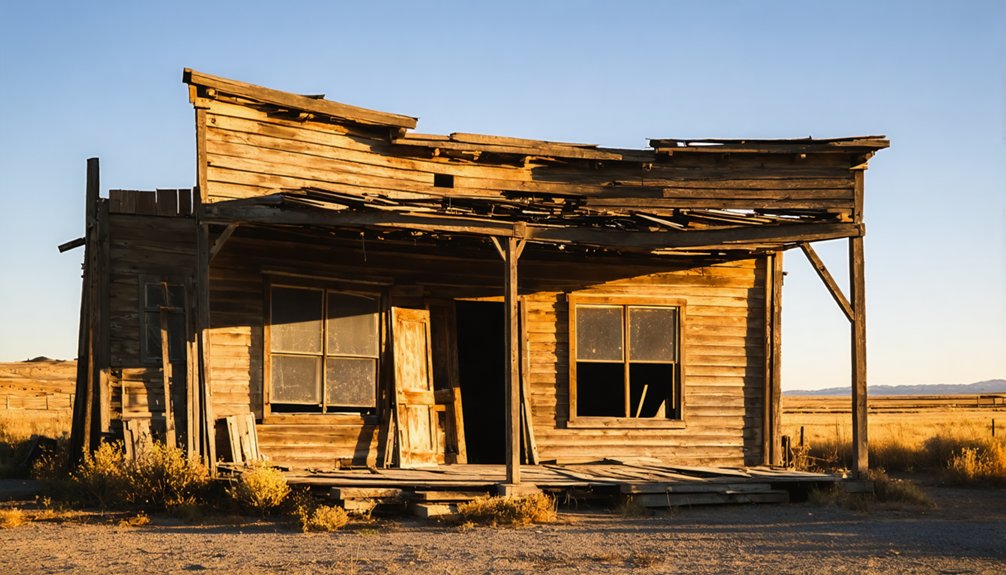You’ll find Silver City perched at 6,200 feet in Idaho’s Owyhee Mountains, where over 70 original structures from the 1860s mining boom still stand. This once-thriving metropolis produced $60 million in precious metals and housed 2,500 residents at its peak, complete with electricity and telephone service well before many major cities. Today, the preserved frontier town operates off-grid, offering you authentic glimpses of the Wild West‘s most dramatic chapters.
Key Takeaways
- Silver City became a ghost town after generating $60 million in precious metals during its peak mining years in the 1800s.
- The town retains 70 original structures from the 1860s-1900s, including the historic Idaho Hotel which still operates today.
- Mining operations ceased by the 1940s, reducing the once-thriving population of 2,500 to a single resident.
- The town is accessible from May to October, featuring off-grid living with solar power and requiring visitors to be self-sufficient.
- Located at 6,200 feet elevation in the Owyhee Mountains, Silver City offers historic exploration and over 500 miles of OHV trails.
The Birth of a Mining Powerhouse
The discovery of gold in the Owyhee region in 1863 sparked one of Idaho Territory’s most remarkable mining booms.
When prospectors found silver on War Eagle Mountain the following year, you’d have witnessed the rapid birth of Silver City, a settlement that quickly transformed into a thriving metropolis of the American West.
The town’s first stamp mill began operations in summer 1864, processing an impressive amount of ore.
By the height of its prosperity, the town generated an astounding 60 million dollars in precious metals from its numerous mines.
Glory Days in the Mountain West
During Silver City’s peak years, you’d find a bustling metropolis that stood as one of Idaho Territory’s most advanced communities. With a population of 2,500 residents, the town’s silver mining operations drew substantial British investments and pioneering technology.
Silver City blazed trails in the Idaho Territory, transforming a mountain outpost into a sophisticated hub of 2,500 souls and British wealth.
You’d witness some of the territory’s first telegraph lines, electric services, and telephone connections, marking Silver City as a beacon of progress in the Mountain West.
The streets buzzed with activity as miners hauled their treasures from War Eagle Mountain, while newspapers reported the latest ghost stories and local happenings. The town served as the proud county seat for nearly seven decades. Like other mining operations of the era, the processing mills crushed minerals into particles, creating tailings that would later impact the environment.
The town’s prosperity reached international acclaim when the Poorman Mine‘s massive 500-pound silver crystal earned a gold medal at the 1867 Paris Exposition, cementing Silver City’s reputation as a premier mining destination.
Life in a Booming Silver Town
You’d find yourself traversing the stark contrasts of frontier life in 1870s Silver City, where the harsh mountain winters and remote location posed daily challenges for its 2,500 residents.
Walking down the bustling streets, you’d pass by the town’s 75 businesses, including saloons, newspapers, and merchants serving the needs of miners and townsfolk alike. The town’s rich silver mining heritage helped establish it as one of the West’s most prosperous settlements. The establishment of Idaho’s first telegraph connected the remote town to the outside world.
The twelve ore-processing mills kept the economy humming, producing more than a million dollars annually in silver while filling the air with the constant sounds of crushing rock and grinding machinery.
Daily Frontier Challenges
Life in Silver City tested even the hardiest frontier settlers, with its remote location 6,200 feet up in the Owyhee Mountains presenting daily challenges.
You’d face constant risks from the more than 100 mines surrounding the town, where accidents and cave-ins were ever-present threats. Remote living meant limited access to basic amenities, and you’d struggle with the harsh mountain environment year-round.
When the Bank of California failed in 1875, you’d have witnessed the devastating economic impact on your mining community.
The boom-and-bust cycles of the mining industry meant you couldn’t count on steady work or reliable income. Even accessing modern conveniences was a daily battle, and you’d need to be self-reliant to survive in this rugged, high-altitude settlement. Despite the challenges, the town boasted impressive technological advances, becoming one of the first to have daily newspapers in the territory. Violent disputes over mining claims frequently erupted, sometimes requiring military intervention to restore order.
Bustling Streets and Commerce
The bustling streets of Silver City echoed with the sounds of a thriving mining community as over 75 businesses served its 4,000 residents during the peak boom years.
You’d find saloons, general stores, and merchants lining the ten carefully planned streets, while stagecoaches brought essential supplies to support the booming population.
With mining operations generating over a million dollars annually in the late 1860s, thriving businesses emerged to meet the town’s growing needs.
You could read updates from two competing newspapers, send telegrams from one of Idaho’s first telegraph offices, or stay at the iconic Idaho Hotel.
Despite high fuel costs due to scarce wood and coal, Silver City’s commerce flourished for two decades, driven by the precious metals that brought prosperity to this frontier boomtown.
Underground Battles and Wild West Drama
You’ll find few Wild West dramas as intense as Silver City’s underground mine battles of the 1860s, where rival companies Ida Elmore and Golden Chariot engaged in fierce gunfights deep beneath Idaho’s mountains.
When over one hundred armed miners exchanged gunfire in the tunnels for three days, leaving two dead and several wounded, the town’s sheriff couldn’t restore order.
The governor ultimately deployed ninety-five soldiers with a cannon to Silver City, requiring four days of military occupation before the mining companies finally settled their territorial disputes through formal agreements.
The city’s mines produced over one million dollars annually during peak operations in the late 1860s.
Six general stores operated during the town’s peak years, serving the bustling community of miners and their families.
Mine Gunfights Below Ground
During March 1868, Silver City erupted into chaos when miners from the Golden Chariot Mine blasted their way into Ida Elmore Mine’s tunnels, sparking one of Idaho Territory’s most dramatic underground conflicts.
This mining conflict quickly escalated into full-scale underground warfare, with nearly 100 armed men exchanging gunfire and explosives in the dark passageways.
You’d have witnessed intense violence as both companies hired additional gunmen, with bullets so thick they nearly severed a 15-inch support beam.
The local sheriff couldn’t stop the mayhem, forcing Governor Ballard to deploy 95 soldiers with a cannon to restore order.
The fighting claimed several lives, including J. Marion More, and left others severely wounded before military intervention finally ended the three-day subterranean battle that had gripped Silver City’s mines.
Military Restores Mountain Peace
While Silver City’s underground mine battles raged in 1868, Major General Frederick Steele‘s military strategy proved crucial for restoring peace to Idaho Territory’s rugged Owyhee region. His inspection of the area led to a calculated military presence that secured critical trade routes and protected the booming mining operations around Silver City.
- You’d have found Camp Winthrop established on Steele’s Soldier Creek site under Brevet Lt. Col. John J. Coppinger’s command.
- The military’s protection of the Minear Road guaranteed your connection to Nevada and California remained safe.
- You could’ve witnessed troops stationed at strategic points to manage conflicts between Native Americans and settlers.
- The military presence helped maintain order in a remote town of 2,500 residents.
- Your mining operations benefited from the peace restoration efforts that supported Silver City’s economic growth.
The Long Path to Ghost Town Status

Silver City’s transformation from a thriving mining hub to a ghost town unfolded gradually over several decades, beginning with the depletion of local ore deposits around 1890.
The ghost town evolution accelerated as mines shuttered or scaled back operations after 1912, leading to a steady exodus of residents and businesses.
You’ll find the mining decline‘s impact reflected in key institutional changes – most significantly when the county seat relocated to Murphy in 1934.
By the 1940s, mining had virtually ceased, and the town’s population dwindled to a single resident who managed multiple civic duties.
The remote location that once bustled with over 75 businesses and 300 homes now stands without electricity or indoor plumbing, sustained only by seasonal residents using solar power or generators.
Preserved Glimpses of the Past
Despite its decline, today’s Silver City stands as a remarkable time capsule of the American West, with roughly 70 original structures dating from the 1860s to early 1900s remaining largely untouched by modernization.
The town’s historic preservation efforts have maintained exceptional architectural integrity, letting you experience authentic 19th-century frontier life. You’ll find the Idaho Hotel operating much as it did a century ago, complete with period furnishings and its classic bar.
- Step into the 1869 Masonic Lodge, still used for town meetings
- Explore the old schoolhouse museum’s curated exhibits of frontier life
- Visit Pat’s What Not Shop for local minerals and historical artifacts
- See the Wells Fargo office with its original fixtures at the Idaho Hotel
- Discover two historic cemeteries that tell tales of early settlers’ lives
Modern Adventures in a Historic Haven

In this remote mountain setting at 6,200 feet elevation, Silver City beckons modern adventurers with a rare blend of untamed wilderness and preserved frontier history.
You’ll find over 500 miles of OHV trails winding through the Owyhee Mountains, perfect for both motorized exploration and hiking adventures during the May-to-October season.
While embracing outdoor exploration, you’ll experience authentic historical preservation through 70 original buildings, including the iconic Idaho Hotel.
You won’t find typical modern amenities here – the town operates completely off-grid, powered by solar panels and propane.
Pack accordingly, as you’ll need to be self-sufficient in this rugged environment.
Beyond rock-hounding and antiquing at local shops, you can immerse yourself in the raw beauty of mountain landscapes while disconnecting from the modern world’s constant connectivity.
Frequently Asked Questions
Are There Any Paranormal or Ghost Sightings Reported in Silver City?
You’ll find numerous ghost encounters at the haunted Idaho Hotel, where visitors report seeing spirits in duster coats, children playing marbles, and a former owner’s presence in Room 27.
Can Visitors Stay Overnight in the Historic Idaho Hotel Today?
Like stepping into a time capsule, you can experience historic accommodations at the Idaho Hotel from Memorial Day through early October. Book your overnight experiences by calling 1-208-583-4104 during operating season.
What’s the Best Time of Year to Visit Silver City?
You’ll find the best seasons are late May through October, when roads are open and weather conditions are favorable. Late spring and early fall offer milder temperatures for exploring the historic buildings.
Are Metal Detectors or Artifact Collecting Allowed in Silver City?
You can’t use metal detectors or collect artifacts in Silver City due to strict metal detecting regulations and artifact preservation efforts. The site’s historic status requires special permits, which aren’t issued for casual detecting.
How Difficult Is the Road Access During Winter Months?
You can’t access the road during winter – it’s officially closed with 4-6 feet of snow conditions. Even if you’re winter-prepared, the treacherous 20-mile dirt route is life-threatening and requires specialized vehicles.
References
- https://www.youtube.com/watch?v=W347SjpcWF0
- https://idahosmammothcave.com/unique-things-to-do-in-idaho-ghost-town-hunting-in-silver-city/
- https://abandonedidaho.com/2024/12/26/silver-city-historical-photos/
- https://westernmininghistory.com/towns/idaho/silver-city/
- https://www.historicsilvercityidaho.com
- https://www.youtube.com/watch?v=rTSZSlxTmbs
- https://www.hhhistory.com/2016/10/a-ghost-town-that-lives-on-by-marilyn.html
- https://www.britannica.com/place/Silver-City-ghost-Idaho
- https://www.youtube.com/watch?v=iS7mvqHQv-8
- https://www.idahogeology.org/pub/Pamphlets/P-131.pdf



